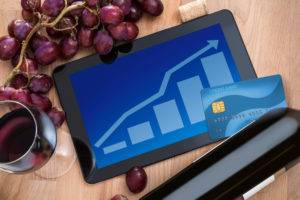The most recent issues of Wine Business Monthly had some astonishing (and telling) things to say about the growth of DTC sales in the wine industry, based on their 2017 Wine Business Monthly/Silicon Valley Bank tasting room survey. We thought it best to highlight some of them, and then ask “Why?”
First and foremost was that DTC sales were up 15% on average (including both tasting rooms and wine clubs), with direct sales now accounting for 60% of winery revenue nationally. We suspect that these numbers would be even higher if we looked only at small-to-medium-sized wineries.
Furthermore, the increase in DTC sales seems attributable to two main factors: 1) A sharp increase in the number of millennials and gen X-ers buying DTC, and 2) An increase in the price of DTC products (i.e., more premium-brand sales vs. simple increase in volume). As these links show, we here at Copper Peak have been reporting on these trends for some time.
But why, as a winery, should you care about the industry trend? We’re reminded of that motherly wisdom: “Well, if everyone jumped off a bridge, would you do it too…?”
Granted, wineries have limited resources, and they need to make careful decisions about where to invest their time and energy. Still, these reports serve as great benchmarks against other wineries. Everyone is trying to, as the article states, “up their game.” If more and more are investing in their DTC models, something is afoot.
What’s Going on with DTC, and Why?
What is going on is that wineries are realizing there is more margin in selling direct to consumers—if you can manage to do it right. This is because:
- DTC sales cut out the middleman. This already means more profit for the winery itself.
- Selling DTC means more opportunities to turn buyers into loyal customers and fans. Selling through restaurants and big box stores does not give brands the opportunity to tell their story and let their personality shine through. Selling direct to consumers, however, affords wineries the ability to build a relationship with potentially loyal customers. These customers tend to spend much more over time, compared to casual buyers.
- DTC allows recommendations and personalization. Once a relationship is built with a consumer, there are many opportunities to personalize the sale: Personal recommendations, “unboxing” experiences, and more.
Again, the demographics are shifting in favor of DTC models: Millennials, for example, are more interested in brand stories, more accustomed to having goods delivered to their home, and more apt to share positive brand experiences on social media. Older generations, for their part, are reaching a stage where they have more disposable income and are willing to experiment with trying premium brands on a more regular basis.
What About Wine Clubs, Specifically?
While the data on tasting rooms are interesting, we should take special note of the survey’s paragraph on wine clubs, located further in the article:
“The most important metrics wineries track include conversion of customers to sales, average rate of conversion to wine club, and length of wine club membership. These metrics are trending upward. Average wine club conversion rates rose to 7 percent in this year’s survey, compared to 6 percent in the previous survey. The average tasting room purchase reached $122 this year. The average wine club member now stays in the club for 30 months.”
This shows that wine clubs are slowly gaining in popularity. Many more wineries are discovering how to run them, and run them according to best practices. (For more on this, see our white paper on subscription services.)
Furthermore, location matters. For example, the greatest percentage of DTC sales coming from wine clubs (as opposed to tasting room sales) are occurring in Napa, Sonoma, Santa Cruz and Monterey, Santa Barbara, and Mendocino County; these regions are the ones showing the largest increase in new members. These are also the regions where the lowest percentage of customers actually live in the region. This signals prime opportunities for wineries in these regions to expand their footprint via wine club sales.
All of which means there is still time to get up to speed with your wine club—but not much. Processes surrounding marketing, social media, fulfillment, and shipping all need to be perfected, and all done with the end customer in mind.
If you don’t, plenty of others will. It is they who will win market share and drive next year’s increases.
If you are considering moves to “up your game,” read our piece on the different kinds of subscription wine models, or else feel free to reach out and call us.




